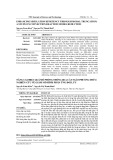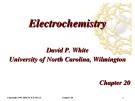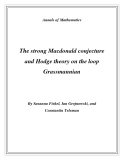
Reduction equations
-
The paper explores the application of the Modal Truncation algorithm in Model Order Reduction, focusing on its effectiveness in reducing high-dimensional mathematical model. The algorithm identifies dominant modes governing dynamic responses, discards the high-order model, and reconstructs a new model with reduced dimensions.
 6p
6p  viengfa
viengfa
 28-10-2024
28-10-2024
 2
2
 1
1
 Download
Download
-
The thesis proposes a simple but very effective method to study the unique solvability and an iterative method for solving five boundary value problems for nonlinear fourth order ordinary differential equations with different types of boundary conditions and two boundary value problems for a biharmonic equation and a biharmonic equation of Kirchhoff type by using the reduction of these problems to the operator equations for the function to be sought or an intermediate function.
 27p
27p  larachdumlanat129
larachdumlanat129
 20-01-2021
20-01-2021
 29
29
 3
3
 Download
Download
-
Balancing oxidation-reduction equations, oxidation-reduction reactions, voltaic cells, cell EMF, effect of concentration on cell EMF is the main content of the lecture "Chapter 20: Electrochemistry". Invite you to consult the detailed content lectures to capture details.
 59p
59p  leminhuy
leminhuy
 01-11-2015
01-11-2015
 38
38
 3
3
 Download
Download
-
We prove the strong Macdonald conjecture of Hanlon and Feigin for reductive groups G. In a geometric reformulation, we show that the Dolbeault cohomology H q (X; Ωp ) of the loop Grassmannian X is freely generated by de Rham’s forms on the disk coupled to the indecomposables of H • (BG). Equating the two Euler characteristics gives an identity, independently known to Macdonald [M], which generalises Ramanujan’s 1 ψ1 sum. For simply laced root systems at level 1, we also find a ‘strong form’ of Bailey’s 4 ψ4 sum. ...
 47p
47p  dontetvui
dontetvui
 17-01-2013
17-01-2013
 59
59
 7
7
 Download
Download
-
The best way to solve equations of the form (19.4.28), including the constant coefficient problem (19.0.3), is a combination of Fourier analysis and cyclic reduction, the FACR method [3-6]. If at the rth stage of CR we Fourier analyze the equations of the form (19.4.32) along y
 9p
9p  babyuni
babyuni
 17-08-2010
17-08-2010
 75
75
 3
3
 Download
Download
CHỦ ĐỀ BẠN MUỐN TÌM

















